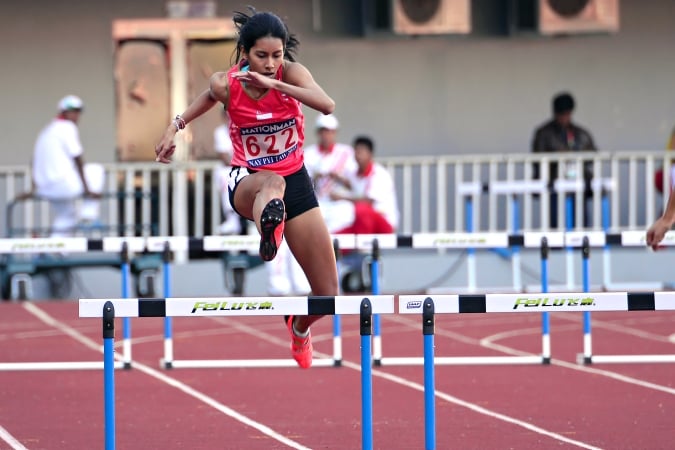What is the right technique for hurdles?

Team Singapore's Dipna Lim Prasad clearing a hurdle at the 27th SEA Games in Myanmar 2013 (photo credit: Andrew JK Tan/SportSG).
MASTER YOUR ATHLETICS TECHNIQUE (2): HURDLES
By Benedict Yeo
The champion hurdler needs to be a fast sprinter, but not necessarily the fastest sprinter. Sprinting and hurdling are quite different sports. To be a great hurdler means that the athlete must be able to jump over obstacles with minimum disruption to his velocity. Hurdling is to run and leap over obstacles while maintaining speed.
Three prominent hurdles event are 110m hurdles (men), 100m (women) and 400m hurdles. The height of each hurdle depends on the age group and gender of the competitors. In the 110m event for men, hurdles are set to be 3.5ft (1.07m) high, whereas in the 100m event for women, the height is set at 2.75ft (0.838m). Regardless of the hurdle heights the number of hurdles that must be cleared in each race remains the same - ten.
This article primarily refers to the technique for 110m hurdles event, but the general principles may apply to the other hurdles events.
Approaching the hurdles – stride patterns
The first of the ten hurdles stands at 13.72m from the starting line. The next nine are evenly spaced at 9.14m from one another. A hurdler would need to figure out his stride pattern – how many strides to take before he reaches the next hurdle?
While it differs from hurdler to hurdler, it is not uncommon to take seven to eight strides to the first hurdle. Beyond the first hurdle, the athlete usually takes three strides to in between all the other hurdles that follow.
Clearing the hurdle
Technique for clearing hurdles (photo credit: http://www.brianmac.co.uk/hurdles/)
When approaching the hurdle, endeavour to overcome it quickly and efficiently. Take off at approximately 2 metres from the hurdle. Bring your leading leg up quickly, and point it towards the hurdle. Then, extend your knee once it reaches the height of the barrier. Keep your knee in line with the vertical axis of your torso.
At about 15cm to 30cm before the hurdle’s rail, the foot of your leading leg should reach its highest point. Pull your leading leg down and back when the heel of your leading leg passes the barrier. As your leg descends, it should straighten. Your foot ideally should land at approximately 1.2m beyond the hurdle.
As for your trailing leg, it should provide some thrust and push your body towards the hurdle. Once past the hurdle, your knee should continue to rise before coming round to the front of your body. However it should not be overly high; allow your knee to descend from the side once it skims past the barrier. An overly high knee will result in a shortened stride and will upset your momentum towards the next hurdle.
To receive the latest updates on the happenings in the Singapore sports scene, or to find out more about some of the latest programmes on offer at ActiveSG, like our Facebook page here.
Are you a youth interested in athletics? Or perhaps a parent with young children with a capacity and talent for running? Join us at the ActiveSG Athletics Club today by registering here.
It is the ideal platform to fulfil athletic potential through courses, clinics and championships. Beyond inculcating sporting values, the training also focuses on developing character and inculcate life values such as integrity, perseverance and teamwork. Training not just to be a better athlete, but a better individual.
So whether at an entry level or embarking on a pathway to excel in it, the ActiveSG Athletics Club is your first choice!





![ActiveSG Academies and Clubs Logo (Solid Colour)[8647]](https://www.activesgcircle.gov.sg/hs-fs/hubfs/ActiveSG%20Circle%202023Theme/images/ActiveSG%20Academies%20and%20Clubs%20Logo%20(Solid%20Colour)%5B8647%5D.png?width=150&height=65&name=ActiveSG%20Academies%20and%20Clubs%20Logo%20(Solid%20Colour)%5B8647%5D.png)



-01.png?width=200&height=141&name=Team%20Singapore%20Logo%20(Red)-01.png)



